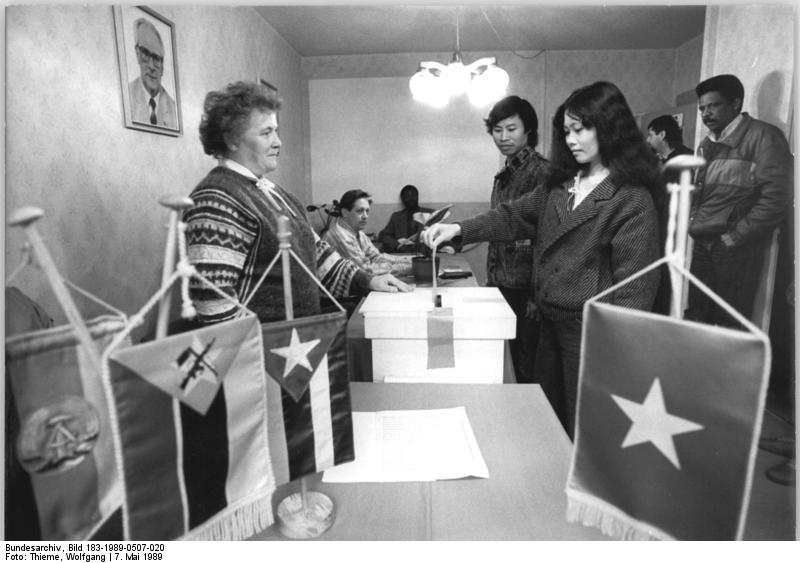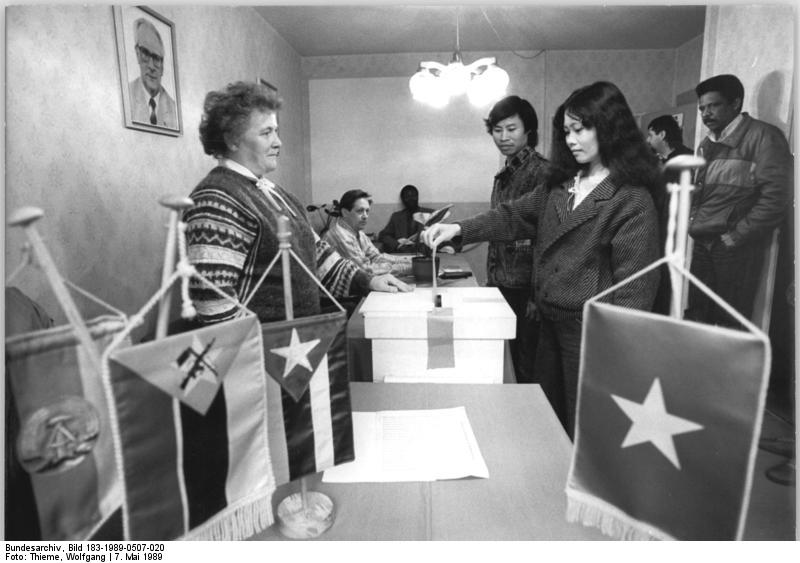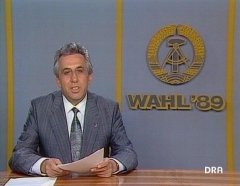07/05 Voter fraud/Wahlfälschung wird bekannt

A turning point for the opposition in the GDR
30 Years Later

Foreign guest workers vote for the communal elections in the GDR 1989, where later the opposition found out about massive voter fraud. ADN-ZB Thieme 7.5.89 Karl-Marx-Stadt: Wahl- Im Wahllokal Wolgograder Allee in Karl-Marx-Stadt machten vietnamesische, kubanische und mocambiquische Werktätige von ihrem Wahlrecht Gebrauch. Vorn: Vo Thi Kim, die als Güterkontrolleur im VEB Barkaswerke Kalr-Marx-Stadt arbeitet.
From today’s perspective the whole voting system in the GDR seems rather strange. The ruling party SED (~ Sozialistische Einheitspartei Deutschlands = Socialist Unity Party of Germany) was the only party that mattered, but it wasn’t the only one. All other parties that were willing to play by the SED’s book, were allowed to become a part of the National Front to create the illusion of plurality. In praxis that meant every party was alloted their share of votes beforehand and voters were just asked to vote “YES”. To vote “No” you had to cross out every name on the ballot, which of course would’ve been registered by polling clerks, resulting in possible trouble for that voter.
In sum, of course this strictly passive “note-folding” as it was jokingly called, had nothing to do with real participation and everyone knew it. Ever since the date for the communal elections was published in January, opposition forces have been discussing how to use them to further an agenda of democratic change or just disrupt the whole process. They found a law that allowed citizens to step up as voluntary voting monitors. If you look at the numbers of previous elections with approval rates of something like 99,7% with an equally high attendance, it’s quite clear that even an election process as stunted as that of the GDR wouldn’t result in numbers like this. So, people decided to take a closer look and try to prove that the authorities were in fact inflating their numbers and insisted on the public counting the constitution guaranteed.
Egon Krenz, the new head of state went in front of the cameras and declared the worst result for the SED ever and people were nearly ready to back off again, until he quoted an approval rate once more of over 98%. Since the monitors counted an average of 7% “No”-votes the fraud wasn’t only obvious – it was provable. Following the elections vigils would be held every 7th of a month to protest the fraud, making these elections a true turning point for the quiet revolution and the fall of the Berlin Wall.
Kommunalwahlen: die Opposition weist Betrug nach
Mauerfall30
Das DDR-Wahlsystem erscheint vielen heute als widersprüchliches Kuriosum. Die SED – (wiki) das Ergebnis der Zwangsvereinigung von SPD und KPD – war zwar die tonangebende aber eben nicht die einzige Partei. Zusammengefasst in der Nationalen Front (wiki) stellten sich eine Reihe von Parteien bzw. Massenorganisationen in einer Einheitsliste zur Wahl, um zumindest den Anschein demokratischer Legitimation durch unterschiedliche gesellschaftliche Gruppen zu erzeugen. Im Klartext bedeutet dass, die Stimmverteilung zwischen SED, “Blockparteien” (gerne auch Blockflötenparteien genannt) und anderen Organisationen vorab feststand und das Wahlvolk durfte zustimmen. Mit “Nein” stimmen konnte nur, wer sich die Mühe machte, jeden einzelnen Namen auf der Wahlliste durchzustreichen, was in der Vergangenheit von den Wahlhelfern durchaus vermerkt wurde und zu ernsthaften Unannehmlichkeiten führen konnte.

Staats- und Parteichef Egon Krenz verliest die offiziellen Ergebnisse der DDR Kommunalwahlen. Quelle: Aktuelle Kamera, Hauptnachrichtensendung des DDR Fernsehen.
Dass diese rein passive “Zettelfalten” mit demokratischer Meinungsbildung nichts zu tun hatte, war den meisten schon lange klar und so ist es nicht verwunderlich, dass seit der Bekanntgabe des Wahltermins im Januar Oppositionelle darüber diskutierten, wie man die bevorstehenden Kommunalwahlen dennoch nutzen bzw. beeinflussen konnte. Dabei stieß man auf ein Gesetz, dass es jedem Bürger erlaubte, sich selbst als Wahlbeobachter einzusetzen. Allen war klar, dass Zustimmungsquoten von 99,7 Prozent bei 99,8 Prozent Wahlbeteiligung allenfalls der Fantasie der Genossen entsprachen. Man nahm sich also vor, nachzuweisen, dass selbst bei einem derart schief konstruiertem Wahlsystem solche Ergebnisse einfach nicht wahr sein konnten. Also wurde in etlichen Wahllokalen auf die gesetzlich garantierte öffentliche Auszählung bestanden.
Als am Abend Egon Krenz das schlechteste Wahlergebnis für die SED aller Zeiten verkündete wurden alle kurz hellhörig, hatten doch die Kontrollen der Bürgerrechtler eine “Nein”-Quote von ca. 7% ergeben. Als Krenz dann eine Zustimmung von weiterhin 98% vermeldete, war der Wahlbetrug nicht nur offensichtlich sondern quasi beweisbar. So wurde dieser Wahlabend zur nächsten großen Niederlage der SED im Jahr 1989. In der Folge fanden jeweils am 07. eines Monats Mahnwachen statt, um gegen die Fälschungen zu protestieren, bspw. auch vor der Gethsemanekirche, die wir bei unserer Mauertour regelmäßig anfahren.
Bei Youtube gibt es übrigens zahlreiche Ausgaben, sowohl von Tagesschau als auch des DDR-Pendants, der Aktuellen Kamera, z.B. auch vom 07. Mai 1989.

